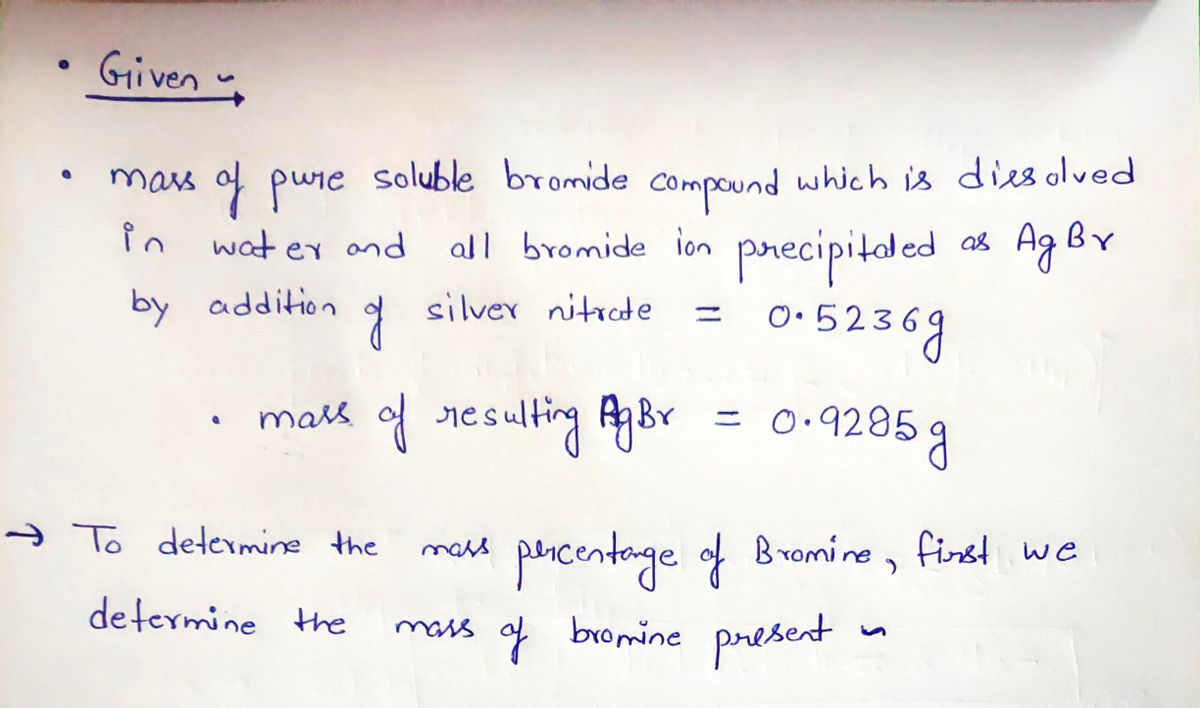A 0.5236 g sample of a pure soluble bromide compound is dissolved in water, and all of the bromide ion is precipitated as AgBr by the addition of an excess of silver nitrate. The mass of the resulting AgBr is found to be 0.9285 g. What is the mass percentage of bromine in the original compound? % Submit Answer 5 question attempts remaining
A 0.5236 g sample of a pure soluble bromide compound is dissolved in water, and all of the bromide ion is precipitated as AgBr by the addition of an excess of silver nitrate. The mass of the resulting AgBr is found to be 0.9285 g. What is the mass percentage of bromine in the original compound? % Submit Answer 5 question attempts remaining
Chemistry
10th Edition
ISBN:9781305957404
Author:Steven S. Zumdahl, Susan A. Zumdahl, Donald J. DeCoste
Publisher:Steven S. Zumdahl, Susan A. Zumdahl, Donald J. DeCoste
Chapter1: Chemical Foundations
Section: Chapter Questions
Problem 1RQ: Define and explain the differences between the following terms. a. law and theory b. theory and...
Related questions
Question

Transcribed Image Text:Séårch th
Use the References to access important values if needed for this question.
A 0.5236 g sample of a pure soluble bromide compound is dissolved in water, and all of the bromide ion is precipitated as AgBr by the
addition of an excess of silver nitrate. The mass of the resulting AgBr is found to be 0.9285 g.
What is the mass percentage of bromine in the original compound?
%
Submit Answer
5 question attempts remaining
Expert Solution
Step 1 Introduction interpretation
Interpretation-
To determine the mass percentage of bromine in the original compound when 0.5236g of pure soluble bromide compound is dissolved in water and all of the bromide ion is precipitated as AgBr by the addition of an excess of sliver nitrate. The mass of resulting AgBr is found to be 0.9285g .
Concept-

Trending now
This is a popular solution!
Step by step
Solved in 3 steps with 3 images

Knowledge Booster
Learn more about
Need a deep-dive on the concept behind this application? Look no further. Learn more about this topic, chemistry and related others by exploring similar questions and additional content below.Recommended textbooks for you

Chemistry
Chemistry
ISBN:
9781305957404
Author:
Steven S. Zumdahl, Susan A. Zumdahl, Donald J. DeCoste
Publisher:
Cengage Learning

Chemistry
Chemistry
ISBN:
9781259911156
Author:
Raymond Chang Dr., Jason Overby Professor
Publisher:
McGraw-Hill Education

Principles of Instrumental Analysis
Chemistry
ISBN:
9781305577213
Author:
Douglas A. Skoog, F. James Holler, Stanley R. Crouch
Publisher:
Cengage Learning

Chemistry
Chemistry
ISBN:
9781305957404
Author:
Steven S. Zumdahl, Susan A. Zumdahl, Donald J. DeCoste
Publisher:
Cengage Learning

Chemistry
Chemistry
ISBN:
9781259911156
Author:
Raymond Chang Dr., Jason Overby Professor
Publisher:
McGraw-Hill Education

Principles of Instrumental Analysis
Chemistry
ISBN:
9781305577213
Author:
Douglas A. Skoog, F. James Holler, Stanley R. Crouch
Publisher:
Cengage Learning

Organic Chemistry
Chemistry
ISBN:
9780078021558
Author:
Janice Gorzynski Smith Dr.
Publisher:
McGraw-Hill Education

Chemistry: Principles and Reactions
Chemistry
ISBN:
9781305079373
Author:
William L. Masterton, Cecile N. Hurley
Publisher:
Cengage Learning

Elementary Principles of Chemical Processes, Bind…
Chemistry
ISBN:
9781118431221
Author:
Richard M. Felder, Ronald W. Rousseau, Lisa G. Bullard
Publisher:
WILEY